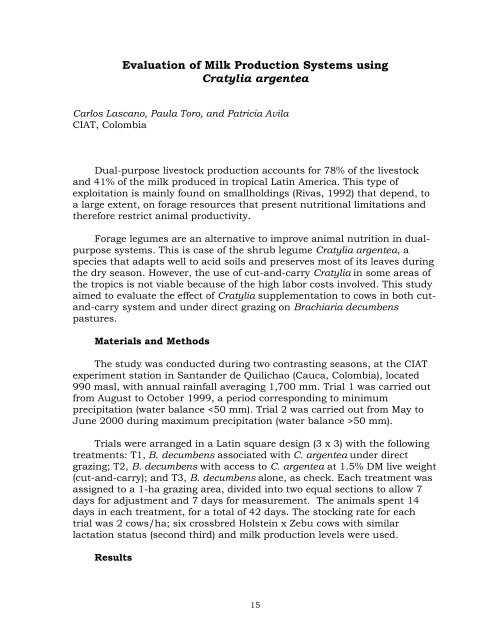Feeding Systems with Legumes to Intensify Dairy Farms - cgiar
Feeding Systems with Legumes to Intensify Dairy Farms - cgiar
Feeding Systems with Legumes to Intensify Dairy Farms - cgiar
You also want an ePaper? Increase the reach of your titles
YUMPU automatically turns print PDFs into web optimized ePapers that Google loves.
Evaluation of Milk Production <strong>Systems</strong> using<br />
Cratylia argentea<br />
Carlos Lascano, Paula Toro, and Patricia Avila<br />
CIAT, Colombia<br />
Dual-purpose lives<strong>to</strong>ck production accounts for 78% of the lives<strong>to</strong>ck<br />
and 41% of the milk produced in tropical Latin America. This type of<br />
exploitation is mainly found on smallholdings (Rivas, 1992) that depend, <strong>to</strong><br />
a large extent, on forage resources that present nutritional limitations and<br />
therefore restrict animal productivity.<br />
Forage legumes are an alternative <strong>to</strong> improve animal nutrition in dualpurpose<br />
systems. This is case of the shrub legume Cratylia argentea, a<br />
species that adapts well <strong>to</strong> acid soils and preserves most of its leaves during<br />
the dry season. However, the use of cut-and-carry Cratylia in some areas of<br />
the tropics is not viable because of the high labor costs involved. This study<br />
aimed <strong>to</strong> evaluate the effect of Cratylia supplementation <strong>to</strong> cows in both cutand-carry<br />
system and under direct grazing on Brachiaria decumbens<br />
pastures.<br />
Materials and Methods<br />
The study was conducted during two contrasting seasons, at the CIAT<br />
experiment station in Santander de Quilichao (Cauca, Colombia), located<br />
990 masl, <strong>with</strong> annual rainfall averaging 1,700 mm. Trial 1 was carried out<br />
from August <strong>to</strong> Oc<strong>to</strong>ber 1999, a period corresponding <strong>to</strong> minimum<br />
precipitation (water balance 50 mm).<br />
Trials were arranged in a Latin square design (3 x 3) <strong>with</strong> the following<br />
treatments: T1, B. decumbens associated <strong>with</strong> C. argentea under direct<br />
grazing; T2, B. decumbens <strong>with</strong> access <strong>to</strong> C. argentea at 1.5% DM live weight<br />
(cut-and-carry); and T3, B. decumbens alone, as check. Each treatment was<br />
assigned <strong>to</strong> a 1-ha grazing area, divided in<strong>to</strong> two equal sections <strong>to</strong> allow 7<br />
days for adjustment and 7 days for measurement. The animals spent 14<br />
days in each treatment, for a <strong>to</strong>tal of 42 days. The s<strong>to</strong>cking rate for each<br />
trial was 2 cows/ha; six crossbred Holstein x Zebu cows <strong>with</strong> similar<br />
lactation status (second third) and milk production levels were used.<br />
Results<br />
15
















